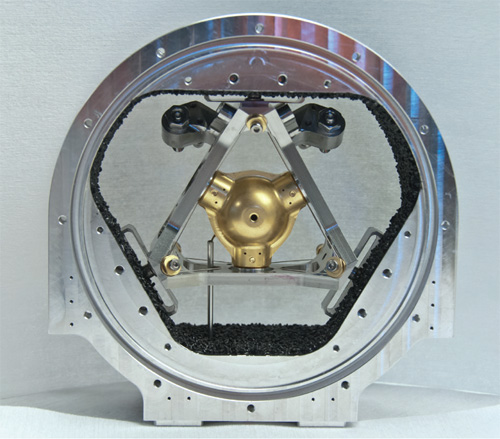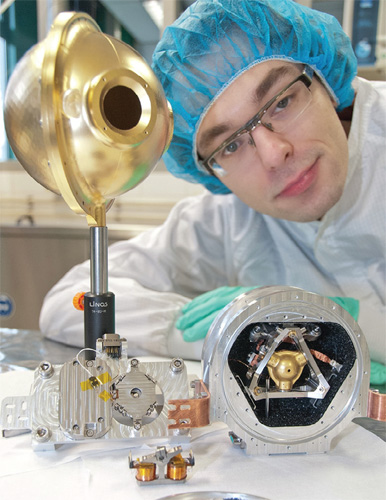
CAD drawing of the radiation source with stainless steel suspension strings (highlighted in red).
Heat management takes on a unique role in outer space, especially for cryogenic systems that demand extremely low temperatures in order to detect thermal radiation. This was a challenge faced by the engineering team at SRON Netherlands Institute for Space Research when designing the SpicA Far-InfraRed Instrument (SAFARI), an infrared camera that measures the complete far-infrared spectrum for each image pixel. SAFARI will fly aboard the Japanese Space Infrared Telescope for Cosmology and Astrophyics (SPICA).
SPICA will look deeper into space than any space telescope has before. Because SAFARI has ultrasensitive detectors cooled to slightly above absolute zero, it can pick up weaker far-infrared radiation than previous space cameras. Precise on-ground and in-space calibration is crucial to the accuracy of the sensors and the success of the mission. To design and optimize these calibration systems, the team at SRON turned to a COMSOL Multiphysics simulation as their guide.

Actual hardware.
 Beating the heat in a telescope calibration system
Beating the heat in a telescope calibration system
The calibration source for SAFARI contains a blackbody cavity, or radiation source, that provides radiation with a spectrum depending only on the source temperature, making it a very reliable and accurate calibrator. “However, SAFARI’s detectors are so sensitive that the power produced by the source is approximately a million times too high and must be optically diluted using apertures and an integrating sphere,” said Chris de Jonge, a design engineer at SRON. “After passing through the integrating sphere, radiation with the correct power and spectral distribution is then reimaged onto SAFARI’s detector arrays for calibration.” Between the radiation source and integrating sphere is a mechanical shutter and iris mechanism. The shutter opens and closes the aperture to the radiation source, while the iris fine-tunes and modulates the output power.

Thermal management is vital: the system is held in a “super-dark” environment at 4.5 kelvins (K) to decrease the background radiation from the equipment itself. Variation in the base temperature of the detectors, background radiation (affected by the orientation of the spacecraft), and power dissipated by the iris and shutter mechanisms can all disrupt calibration.
“The radiation source temperature can be set between 95 and 300 K to generate radiation—this creates a large temperature differential between the source and the 4.5 K environment, while available cooling power at these temperatures is limited to just tens of milliwatts,” de Jonge explained. “To account for this, we needed to design a thermally insulating suspension system.” The SRON team needed a stiff suspension with a high resonance frequency that would prevent heat transfer from the source to the rest of the device while also protecting it from unwanted vibrations.
 Designing a thermally insulating suspension system
Designing a thermally insulating suspension system
Using COMSOL simulations, de Jonge evaluated the heat load through the suspension and performed modal analyses on suspension concepts with different geometries and materials, seeking a tradeoff between mechanical stiffness and thermal load.
“Because of the large temperature gradient over the brackets and thermal properties that change very quickly as a function of temperature, temperature-dependent material properties had to be implemented,” he said. “Ultimately, we chose the solution that had the best combination of mechanical stiffness and thermal insulation.”
Based on the results, the team designed and optimized a configuration of thin (100 µm) stainless steel wires to hold the radiation source to a triangular frame.
Because stainless steel has low thermal conductivity at cryogenic temperatures and the cross-section of the wires is very small, heat conduction through the wires was limited, which the simulation confirmed. For a source temperature of 150 K, the experimental analysis showed 10.17 mW of conducted heat. The simulation results were in close agreement, accurate to within 0.01 mW. The design also had a resonant frequency of 720 Hz, high enough to ensure proper functioning of the radiation source.

Chris de Jonge, design engineer at SRON, working on the SAFARI calibration system.
Optimizing the iris and shutter for maximum efficiency
Next, de Jonge optimized the coil-driven iris and shutter mechanisms. The iris is driven by a voice-coil actuator and contains four stainless steel blades that rotate around frictionless bearings. The shutter is a magnetic latching device.
De Jonge used COMSOL to optimize the iris coil and housing geometry, aiming to minimize the current and dissipated heat during actuation. By performing a parametric sweep over the main design parameters on the air gap and number of coil windings, the team developed an optimal coil design that has a low driving current of 38 mA and a dissipation of just 1.6 mW.
SRON’s thermally stable deep-space sensing system is on the way
Because of SAFARI’s sensitive detectors and the need for dissipative mechanisms in cryogenic systems, maintaining a controlled thermal environment is vital to the success of SPICA’s mission. COMSOL allowed de Jonge and the team at SRON to optimize their design for the best thermal, material and structural conditions possible at extremely low temperatures. Their first tests of the SAFARI calibration source confirm the accuracy of the COMSOL simulations. SPICA is scheduled to launch into orbit in 2022, when SAFARI will help us unveil new mysteries of space beyond our solar system.
COMSOL
www.comsol.com
Filed Under: Aerospace + defense, Software • 3D CAD, Flanges • supports • mounts • brackets, Software • simulation, MOTION CONTROL, MORE INDUSTRIES





Tell Us What You Think!